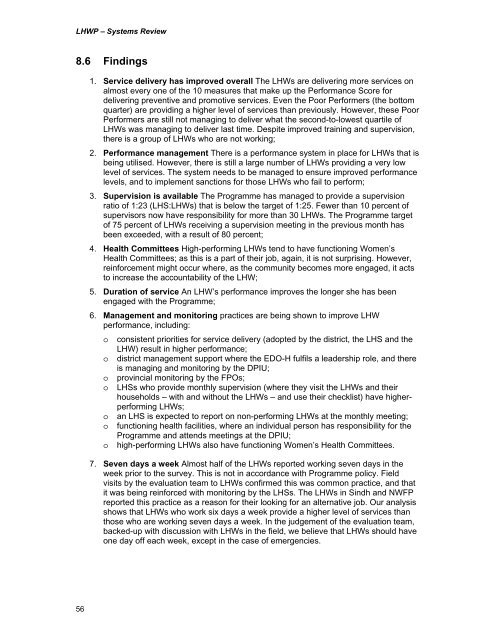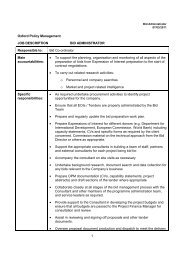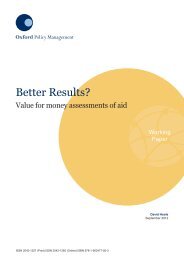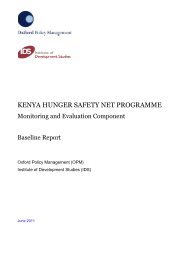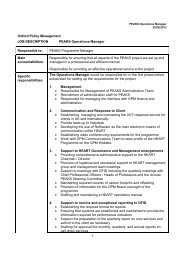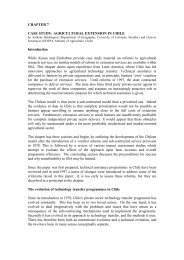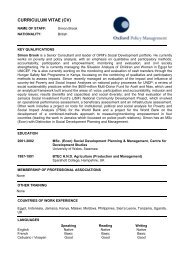LHW Systems Review - Oxford Policy Management
LHW Systems Review - Oxford Policy Management
LHW Systems Review - Oxford Policy Management
Create successful ePaper yourself
Turn your PDF publications into a flip-book with our unique Google optimized e-Paper software.
<strong>LHW</strong>P – <strong>Systems</strong> <strong>Review</strong>8.6 Findings1. Service delivery has improved overall The <strong>LHW</strong>s are delivering more services onalmost every one of the 10 measures that make up the Performance Score fordelivering preventive and promotive services. Even the Poor Performers (the bottomquarter) are providing a higher level of services than previously. However, these PoorPerformers are still not managing to deliver what the second-to-lowest quartile of<strong>LHW</strong>s was managing to deliver last time. Despite improved training and supervision,there is a group of <strong>LHW</strong>s who are not working;2. Performance management There is a performance system in place for <strong>LHW</strong>s that isbeing utilised. However, there is still a large number of <strong>LHW</strong>s providing a very lowlevel of services. The system needs to be managed to ensure improved performancelevels, and to implement sanctions for those <strong>LHW</strong>s who fail to perform;3. Supervision is available The Programme has managed to provide a supervisionratio of 1:23 (LHS:<strong>LHW</strong>s) that is below the target of 1:25. Fewer than 10 percent ofsupervisors now have responsibility for more than 30 <strong>LHW</strong>s. The Programme targetof 75 percent of <strong>LHW</strong>s receiving a supervision meeting in the previous month hasbeen exceeded, with a result of 80 percent;4. Health Committees High-performing <strong>LHW</strong>s tend to have functioning Women’sHealth Committees; as this is a part of their job, again, it is not surprising. However,reinforcement might occur where, as the community becomes more engaged, it actsto increase the accountability of the <strong>LHW</strong>;5. Duration of service An <strong>LHW</strong>’s performance improves the longer she has beenengaged with the Programme;6. <strong>Management</strong> and monitoring practices are being shown to improve <strong>LHW</strong>performance, including:o consistent priorities for service delivery (adopted by the district, the LHS and the<strong>LHW</strong>) result in higher performance;o district management support where the EDO-H fulfils a leadership role, and thereis managing and monitoring by the DPIU;oooooprovincial monitoring by the FPOs;LHSs who provide monthly supervision (where they visit the <strong>LHW</strong>s and theirhouseholds – with and without the <strong>LHW</strong>s – and use their checklist) have higherperforming<strong>LHW</strong>s;an LHS is expected to report on non-performing <strong>LHW</strong>s at the monthly meeting;functioning health facilities, where an individual person has responsibility for theProgramme and attends meetings at the DPIU;high-performing <strong>LHW</strong>s also have functioning Women’s Health Committees.7. Seven days a week Almost half of the <strong>LHW</strong>s reported working seven days in theweek prior to the survey. This is not in accordance with Programme policy. Fieldvisits by the evaluation team to <strong>LHW</strong>s confirmed this was common practice, and thatit was being reinforced with monitoring by the LHSs. The <strong>LHW</strong>s in Sindh and NWFPreported this practice as a reason for their looking for an alternative job. Our analysisshows that <strong>LHW</strong>s who work six days a week provide a higher level of services thanthose who are working seven days a week. In the judgement of the evaluation team,backed-up with discussion with <strong>LHW</strong>s in the field, we believe that <strong>LHW</strong>s should haveone day off each week, except in the case of emergencies.56


